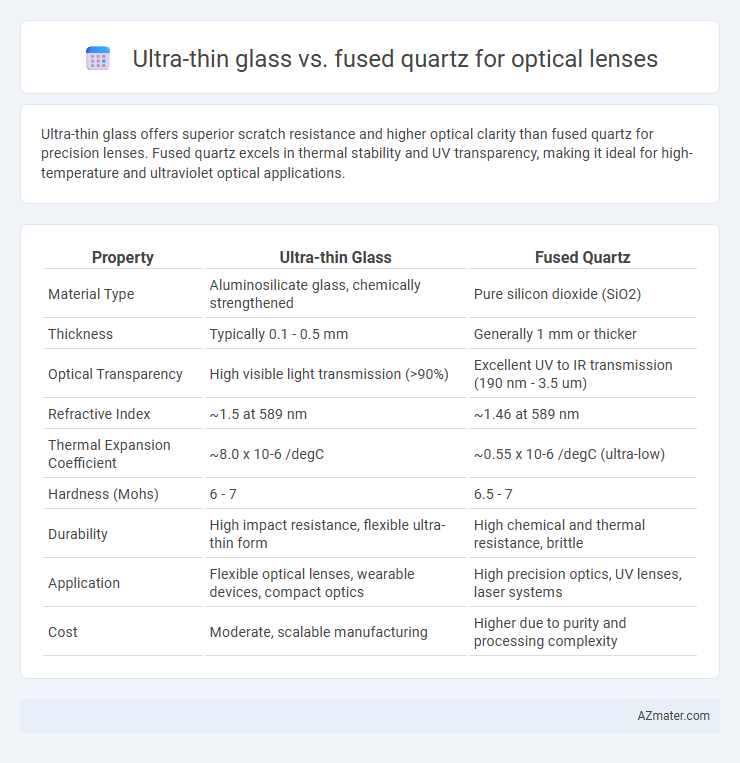Ultra-thin glass offers superior scratch resistance and higher optical clarity than fused quartz for precision lenses. Fused quartz excels in thermal stability and UV transparency, making it ideal for high-temperature and ultraviolet optical applications.
Table of Comparison
| Property | Ultra-thin Glass | Fused Quartz |
|---|---|---|
| Material Type | Aluminosilicate glass, chemically strengthened | Pure silicon dioxide (SiO2) |
| Thickness | Typically 0.1 - 0.5 mm | Generally 1 mm or thicker |
| Optical Transparency | High visible light transmission (>90%) | Excellent UV to IR transmission (190 nm - 3.5 um) |
| Refractive Index | ~1.5 at 589 nm | ~1.46 at 589 nm |
| Thermal Expansion Coefficient | ~8.0 x 10-6 /degC | ~0.55 x 10-6 /degC (ultra-low) |
| Hardness (Mohs) | 6 - 7 | 6.5 - 7 |
| Durability | High impact resistance, flexible ultra-thin form | High chemical and thermal resistance, brittle |
| Application | Flexible optical lenses, wearable devices, compact optics | High precision optics, UV lenses, laser systems |
| Cost | Moderate, scalable manufacturing | Higher due to purity and processing complexity |
Introduction to Optical Lens Materials
Ultra-thin glass and fused quartz are critical materials in the fabrication of optical lenses due to their distinct physical and chemical properties. Ultra-thin glass offers exceptional flexibility, lightweight characteristics, and high transparency, making it ideal for compact, high-performance optical systems. Fused quartz provides superior thermal stability, low thermal expansion, and excellent UV light transmission, which are essential for precision optics in demanding environments.
Overview of Ultra-thin Glass
Ultra-thin glass offers exceptional clarity, high scratch resistance, and superior flexibility compared to fused quartz, making it ideal for advanced optical lens applications. Its lightweight and ultra-thin structure enable enhanced precision and improved light transmission, crucial for next-generation imaging technologies. Unlike fused quartz, ultra-thin glass can be manufactured with tailored thicknesses and curved surfaces, providing greater design versatility in optical components.
Properties of Fused Quartz
Fused quartz exhibits exceptional optical clarity with a high transmission rate across ultraviolet to infrared wavelengths, making it ideal for precision optical lenses. Its low thermal expansion coefficient enhances dimensional stability under varying temperatures, ensuring consistent optical performance. Additionally, fused quartz offers superior chemical resistance and mechanical strength compared to ultra-thin glass, contributing to its durability in harsh environments.
Optical Clarity and Transmission
Ultra-thin glass offers superior optical clarity with minimal surface distortion, making it ideal for high-precision lenses requiring sharp image resolution. Fused quartz demonstrates excellent transmission across ultraviolet to infrared wavelengths, ensuring minimal signal loss in diverse optical applications. While ultra-thin glass provides enhanced clarity for visible light, fused quartz excels in broadband transmission and durability under high thermal stress.
Thermal Stability and Resistance
Ultra-thin glass offers superior thermal stability with a low coefficient of thermal expansion, ensuring minimal distortion under varying temperatures, making it ideal for precision optical lenses. Fused quartz exhibits exceptional resistance to thermal shock and can withstand extreme temperature fluctuations without cracking, which is critical for high-power laser applications. Both materials provide excellent optical clarity, but ultra-thin glass excels in environments demanding stringent thermal dimensional stability, whereas fused quartz is preferred for harsh thermal resistance.
Mechanical Strength Comparison
Ultra-thin glass exhibits superior mechanical strength compared to fused quartz, offering enhanced resistance to scratches and impact damage due to its higher tensile strength and flexible nature. Fused quartz, while highly resistant to thermal expansion and chemical erosion, tends to be more brittle and prone to fracture under mechanical stress. The toughness of ultra-thin glass makes it a preferred choice for optical lenses requiring durability in demanding environments.
Manufacturing Flexibility and Scalability
Ultra-thin glass offers superior manufacturing flexibility compared to fused quartz due to its ability to be precisely molded, cut, and coated in various complex shapes, enabling customized and lightweight optical lens designs. Its scalability benefits from well-established industrial processes that support mass production without significant quality degradation, whereas fused quartz demands more energy-intensive machining and polishing, limiting high-volume scalability. Consequently, ultra-thin glass is favored for applications requiring rapid prototyping and scalable production of high-performance optical lenses.
Application Suitability in Optics
Ultra-thin glass offers exceptional flatness and hardness, making it ideal for high-precision optical lenses in compact devices such as smartphones and wearable optics. Fused quartz provides superior thermal stability and UV transmission, suited for high-power laser systems and harsh environmental conditions in scientific instrumentation. Choice between ultra-thin glass and fused quartz depends on specific application requirements like mechanical durability, wavelength range, and operating temperature.
Cost Efficiency Analysis
Ultra-thin glass offers superior cost efficiency over fused quartz for optical lenses due to lower raw material costs and reduced processing time, enabling faster production cycles. The manufacturing techniques for ultra-thin glass involve less energy-intensive steps compared to the high-temperature fusion methods required for quartz, resulting in significant savings. Although fused quartz delivers excellent thermal and optical properties, the increased fabrication expenses and longer lead times make ultra-thin glass a more economical choice for large-scale lens production.
Future Trends in Lens Material Technology
Ultra-thin glass is emerging as a game-changer in optical lens material technology due to its exceptional flexibility, reduced weight, and enhanced durability compared to traditional fused quartz. Advances in manufacturing techniques, such as precision thinning and chemical strengthening, are enabling ultra-thin glass to deliver high optical clarity while supporting compact, lightweight lens designs critical for augmented reality (AR) and wearable devices. Future trends indicate a shift towards hybrid materials combining ultra-thin glass with innovative coatings to improve scratch resistance, thermal stability, and overall performance in next-generation optical applications.

Infographic: Ultra-thin glass vs Fused quartz for Optical lens
 azmater.com
azmater.com